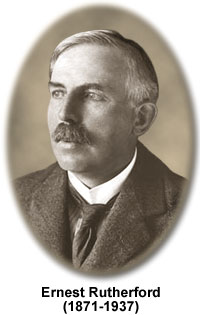Ernest Rutherford
(1871-1937)

Distinguished experimental physicist and Nobel Prize laureate Ernest Rutherford was born in Spring Grove, New Zealand on August 30, 1871. He was one of twelve children, but his early educational success set him apart. He was chosen to enroll at the Nelson Collegiate School, which was followed by an academic award to attend Canterbury College in Christchurch, New Zealand in 1889. There he majored in mathematics and physics, graduating in 1893, though remaining for another year of research. Based on his work, which employed the magnetic properties of iron to detect radio waves, Rutherford received a scholarship provided from the profits of the 1851 Exhibition and decided to attend England's Trinity College at Cambridge University.
As a research student at Cambridge, Rutherford had the opportunity to work with the renowned physicist J. J. Thomson at the Cavendish Laboratory. During his three-year stay, Rutherford investigated the conductivity of gas ionized by radiation and discovered the existence of two distinct types of rays in uranium radiation. Those that were more powerful, but easily absorbed, he termed alpha rays, while those that produced less radiation and had greater penetration ability were termed beta rays. In 1898, Rutherford accepted the physics chair at the illustrious McGill University in Canada, ending his work with Thomson. However, the knowledge and confidence he gained during those years would carry him through a long and prestigious career.
At McGill he continued his research on radioactivity, demonstrating in 1902 with the help of Frederick Soddy that radioactive elements can spontaneously shed protons and neutrons (in the form of smaller atoms), transfiguring them into different elements. Although many scientists were skeptical of the findings, which seemed reminiscent of medieval alchemy, the Royal Society soon elected Rutherford a fellow and awarded him the Rumford Medal in 1904. That same year he published the book Radio-Activity, making his ideas familiar to a wider audience. Although he turned down various other appointment offers as he become more famous in the scientific world, in 1907 he accepted a position at the University of Manchester. Once again in England, Rutherford developed a center dedicated to radiation studies and received the Nobel Prize in Chemistry in 1908 for his work in that field.
In 1911, however, Rutherford completed what would be his most lasting contribution to science. Based on studies of alpha particles passing through thin plates of mica and gold, Rutherford came to the conclusion that the intense electric field required to cause the large deflections that were occurring could be explained only if all the positive charge in the atom were concentrated on a very small central nucleus. He further postulated that the positive charge on the nucleus must be balanced by an equal charge on all the electrons distributed around the nucleus. Rutherford's atomic model paved the way for the modern understanding of the atom. It was also the foundation of the important developments regarding the structure of atoms made by Niels Bohr, who was once his protégée.
The Rutherford Experiment - This classic diffraction experiment, which examined diffraction of alpha particles (helium nuclei containing two positive charges) by a thin foil made of gold metal, was conducted in 1911 by Hans Geiger and Ernest Marsden at the suggestion of Ernest Rutherford. Geiger and Marsden expected to find that most of the alpha particles travel straight through the foil with little deviation, with the remainder being deviated by a percent or two. This thinking was based on the theory that positive and negative charges were spread evenly within the atom and that only weak electric forces would be exerted on the alpha particles that were passing through the thin foil at high energy.
What they found, to great surprise, was that while most of the alpha particles passed straight through the foil, a small percentage of them were deflected at very large angles and some were even backscattered. Because alpha particles have about 8000 times the mass of an electron and impacted the foil at very high velocities, it was clear that very strong forces were necessary to deflect and backscatter these particles. Rutherford explained this phenomenon with a revitalized model of the atom in which most of the mass was concentrated into a compact nucleus (holding all of the positive charge), with electrons occupying the bulk of the atom's space and orbiting the nucleus at a distance. With the atom being composed largely of empty space, it was then very easy to construct a scenario where most of the alpha particles passed through the foil, and only the ones that encountered a direct collision with a gold nucleus were deflected or scattered backwards.
